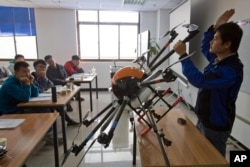She may not be the warmest waitress, but she serves a nice, hot cup of “Joe” at a café on the outskirts of Ho Chi Minh City.
Though this robotic barista is still getting help from her human counterpart, she is a signal that Asia is ahead of the curve in embracing new technologies ahead of the Americas, Europe, the Middle East, and Africa.
A recent report from PwC Global, a professional services firm, studied 1,155 manufacturing businesses based on how much they were embracing and incorporating innovations in technology, from drones to 3-D printing.
Across the board, companies in the Asia-Pacific region scored higher than their counterparts elsewhere in the world.
In Thailand, for instance, manufacturing companies have widely adopted new technologies to transform their operations.
“Many are using robots to assemble products at their factories to rely less on human labor, reduce costs, and boost overall efficiency,” said Vilaiporn Taweelappontong, consulting lead partner at PwC Thailand.
ASEAN catches up
The report graded firms based on questions about the kinds of tools they were introducing into their workplaces. For example, manufacturers were asked if they made use of virtual reality; 44 percent in the Asia Pacific said they did compared with 34 percent in the United States and 19 percent in Europe, the Middle East, and Africa.
The regional group Association of Southeast Asian Nations (ASEAN) reports that small and medium enterprises are using new technology to catch up to bigger rivals.
“Digitization is enabling SMEs across ASEAN to participate in cross-border trade, allowing them to grow and scale their businesses while reducing costs,” said Bidhan Roy, a general manager at Cisco Systems Pte Ltd.
Benefits of youth
Observers say the Asia-Pacific region benefits from its youth.
The relatively young population means people are amenable to different work environments and business operations, as well as having a keen interest in using new technology.
Another advantage? The region’s economies are also somewhat young, with many just opening up to global trade in the last two decades. In addition its underdeveloped infrastructure has the ability to adapt for future needs, like public transit or drone deliveries.
“Asian companies have the advantage of setting up robust digital operations from essentially a blank slate in terms of factory automation, workforce, and even organizational IT [information technology] networks as a whole,” the PwC report said.
Baby steps
But more is needed to make these companies successful.
Cisco Systems’ Roy noted that small and medium firms “are at varying stages of maturity in terms of digital adoption” and could use collaboration with governments and corporations.
PwC Thailand’s Vilaiporn agreed on the benefit of collaboration.
“Thailand 4.0 will only be successful if both the government and private sectors understand their roles in fostering investment and focusing on research and development, as well as equipping the workforce with necessary skill sets and capabilities,” he said.
The “4.0” refers to the latest industrial revolution, which goes beyond mechanization and automation. It entails business processes becoming more efficient through a comprehensive application of technology, from smart devices to machine learning.











